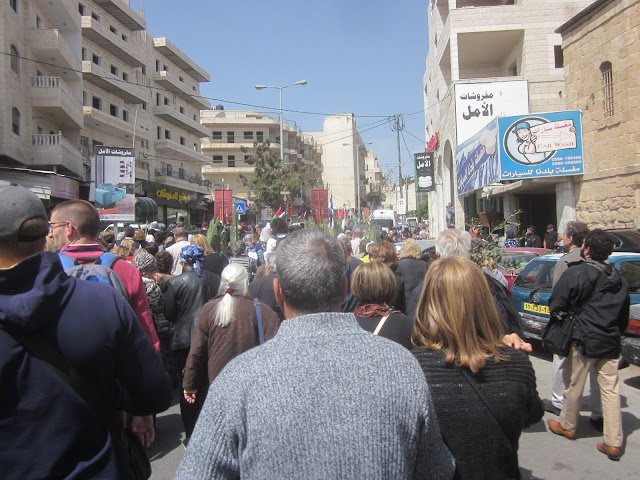We were offered some alternate experiences: to go to the "Garden Tomb," a site beloved by protestant and evangelical types or take free time. The Garden Tomb offers 1. A garden, and 2. A tomb from well before the 1st century A.D., but has no validity as "the tomb from which Jesus rose from the dead." It came about because 19th century Protestant (romantics and pietists mostly, certainly not historians or archaeologists) didn't like the traditional site being in the hands of the Orthodox and Catholics. So, they set about to find "the true location" of the tomb. They found this tomb and some evidence of a garden, and imagined a nearby rock formation to look like a skull, and declared their findings to be the authentic site, rather than the one which tradition and archaeology have identified and venerated since the fourth century. I will say this. If you want to see a tomb that looks like the one pictured in your Sunday school books, The Garden Tomb is your best choice. If you prefer authenticity, then the contents of the Holy Sepulcher take the prize.
I had a nice time reintroducing myself to the Garden Tomb, and I was amazed at the number of church groups who were there holding services. As a rule, the Garden Tomb is pretty quiet and has smarmy quasi religious music piped in. This day, the din from guitars and sound systems pretty well overpowered any peaceful thoughts or intentions. Those evangelicals .... always so willing to share their enthusiasm.
Our supplemental afternoon activity turned out to be a real stroke of luck. We were permitted to be at the Russian Orthodox Chapel when the Holy Fire arrived from the Holy Sepulcher after 2:00 pm. There is a practice, here, of distributing the Holy Fire to as many churches as possible. At the conclusion of the Holy Fire service in the Holy Sepulcher, runners head out in various directions, some even to the airport, to carry the Holy Fire to outlying locations where Orthodoxy predominates. We arrived at the Russian Chapel at just the right moment.
While my Russian is not what it needed to be, it was fairly easy to follow the Bishop as he read some scripture and delivered an impassioned sermon that I'm sure had something to do with Easter and/or the resurrection. The music, as always in the Russian church, was phenomononal ... celebratory without being gushy or sentimental.
We left the delivery of the Holy Fire service feeling like we had not missed anything, and had certainly avoided the much more uncomfortable Holy Fire service at the Holy Sepulcher. Comfort, I believe, takes on a much higher priority with age and I am willing to say that I have arrive there.
The Easter Vigil service at the Cathedral of Saint George the Martyr was very familiar in form, being from the American Prayer Book. Local variations included the usual bilingual acommodations and the service was much shorter than most of us are accustomed to. Yet, the essentials were all there, and we closed out the day very much satisfied. It was different than we had expected, but, in actuality better!

































